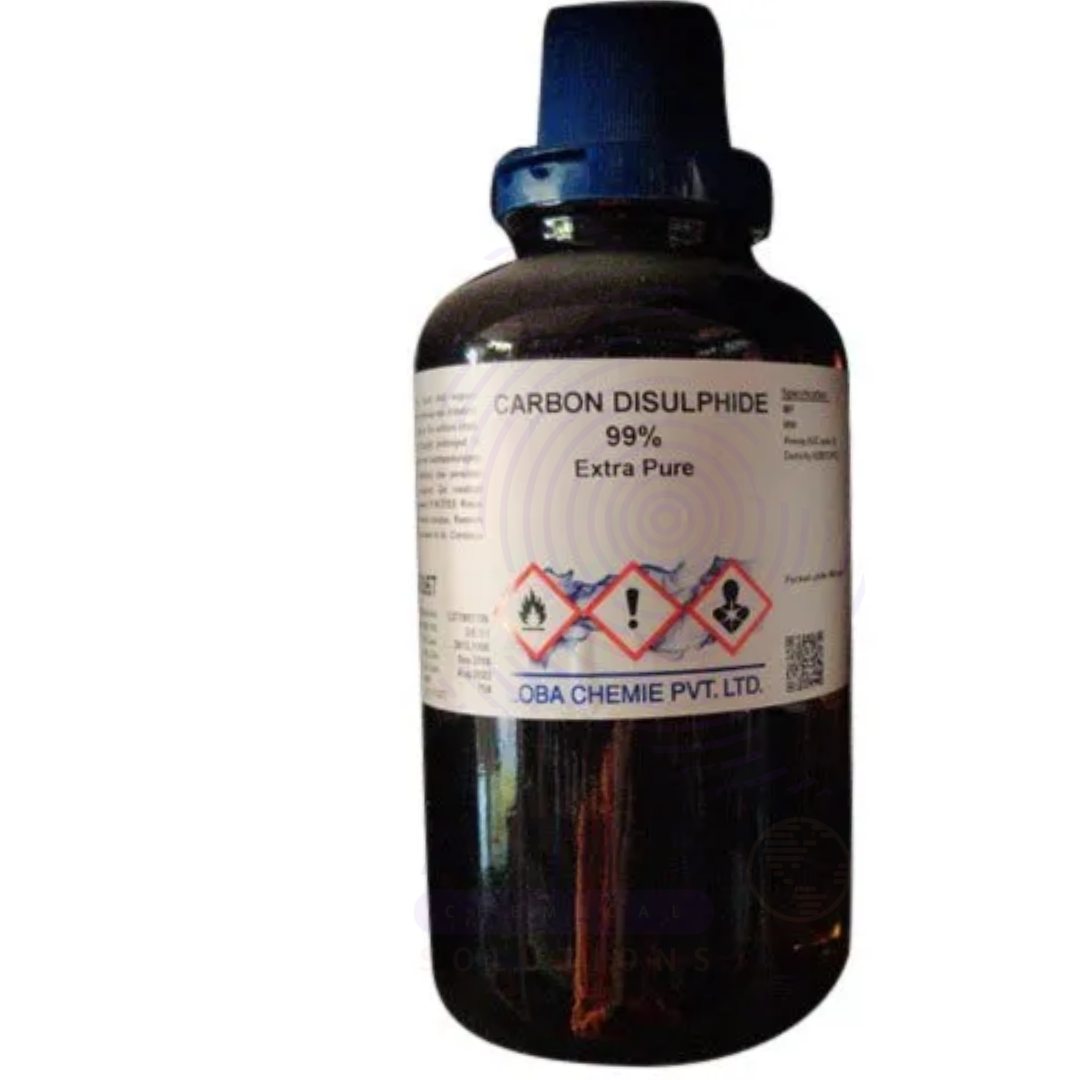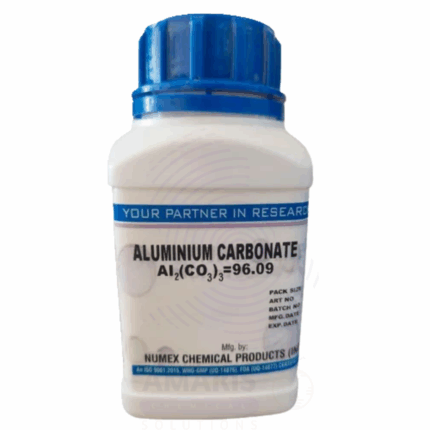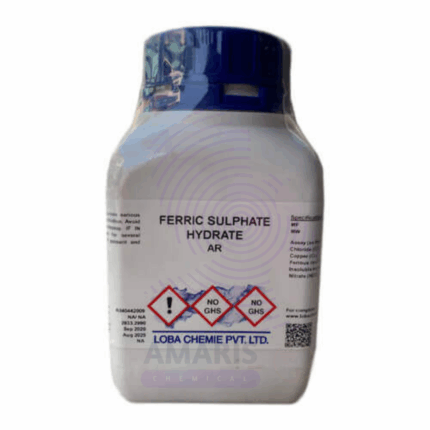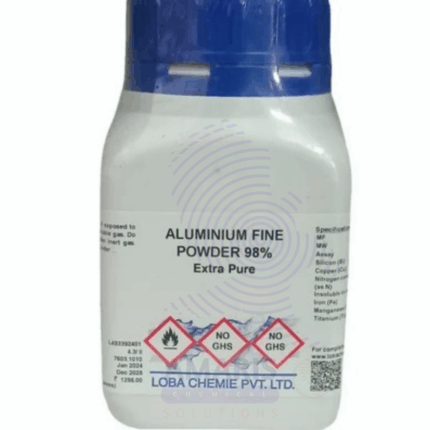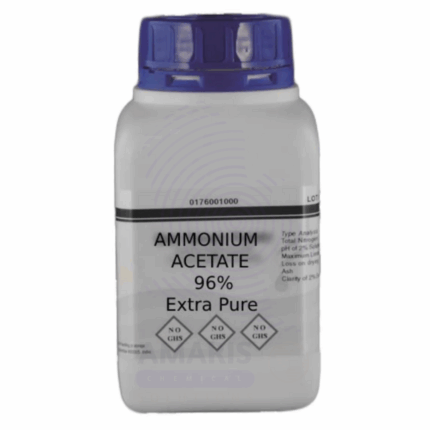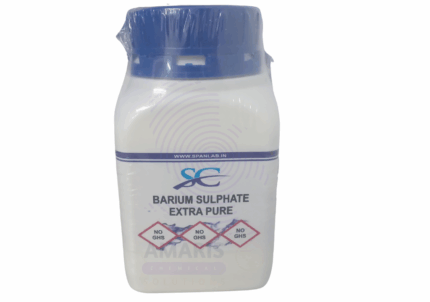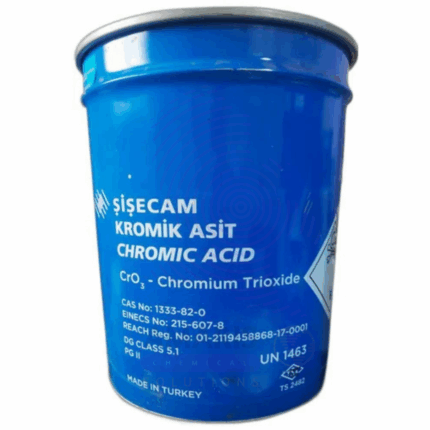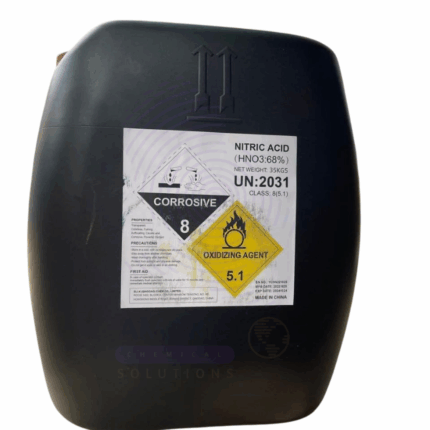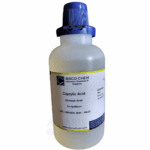
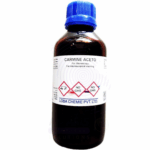
Carbon Disulfide Extra Pure
$ 18.00 Original price was: $ 18.00.$ 17.87Current price is: $ 17.87.
Carbon Disulfide Extra Pure is a volatile, colorless to pale yellow liquid with a strong, characteristic odor, valued in laboratory settings for its high purity and solvency power. Commonly used as a non-polar solvent, it is ideal for dissolving sulfur, fats, resins, and phosphorus in analytical and synthetic chemistry. Its role extends to studying reaction kinetics, extraction processes, and as a reagent in organic synthesis involving thiocarbonyl compounds. Due to its low flash point and high volatility, it is also utilized in vapor pressure and flammability studies. The 99% extra pure grade ensures minimal impurities, critical for sensitive applications. It must be handled in a well-ventilated fume hood and stored away from heat, sparks, and oxidizing agents.
Carbon Disulfide Extra Pure
Primary Uses
- Solvent for Non-Polar Compounds
- Commonly used as a non-polar solvent for lipids, resins, phosphorus, sulfur, iodine, and rubber in analytical and organic chemistry labs.
- Spectroscopy & Chromatography
- Used in UV-visible and IR spectroscopy due to its wide transparency range and low absorbance in certain spectral regions.
- Chemical Reagent in Organic Synthesis
- Acts as a reagent or intermediate in synthesis of:
- Dithiocarbamates
- Xanthates
- Thiocarbonyl compounds
- Acts as a reagent or intermediate in synthesis of:
- Sulfur Compound Studies
- Serves as a model compound in studies of sulfur reactivity, coordination chemistry, and catalytic processes.
Secondary Uses
- Microscopy Mounting Medium
- Occasionally used as a refractive index-matching medium in microscopy.
- Polymer & Material Science Research
- Employed in dissolving rubber and cellulose xanthate (from viscose rayon) for research and testing purposes.
- Environmental Chemistry
- Used in trace analysis of volatile sulfur compounds in air and soil samples.
- Explosive Properties Studies (Controlled Research Only)
- Studied under strict lab controls for understanding volatile organic compound (VOC) behavior or flammability indices.
| PACK SIZE |
500 grams Plastic Tin |
|---|
1. Basic Identification Attributes
- Chemical Name: Carbon Disulfide
- Grade: 99% Extra Pure (Laboratory Grade)
- CAS Number: 75-15-0
- Molecular Formula: CS₂
- Synonyms: Carbon Bisulfide, Dithiocarbonic Anhydride
2. Physical & Chemical Properties
- Appearance: Colorless to faint yellow volatile liquid
- Odor: Strong, sweet ether-like odor (toxic and unpleasant at high concentrations)
- Molecular Weight: 76.13 g/mol
- Boiling Point: ~46.3 °C
- Melting Point: ~ -111.5 °C
- Density: 1.263 g/cm³ at 20 °C
- Solubility: Slightly soluble in water; miscible with ethanol, ether, benzene, and chloroform
- Vapor Pressure: High (around 352 mmHg at 25 °C)
- Flash Point: -30 °C (closed cup)
- Autoignition Temperature: ~102 °C
3. Safety & Hazard Attributes
- GHS Classification:
- Flammable Liquid – Category 2
- Acute Toxicity (Inhalation, Oral, Dermal) – Category 3
- Specific Target Organ Toxicity (Repeated Exposure) – Category 1
- Hazard Statements:
- H225: Highly flammable liquid and vapor
- H301 + H311 + H331: Toxic if swallowed, in contact with skin, or if inhaled
- H372: Causes damage to organs through prolonged or repeated exposure
- Precautionary Statements:
- P210: Keep away from heat/sparks/open flames
- P260: Do not breathe vapors
- P280: Wear protective gloves/protective clothing/eye protection
4. Storage & Handling Attributes
- Storage Conditions:
- Store in a cool, well-ventilated, explosion-proof area
- Keep tightly sealed in approved flammable storage cabinets
- Protect from heat, sparks, and open flames
- Handling Precautions:
- Use only in fume hood
- Avoid inhalation and contact with skin or eyes
- Ground and bond containers when transferring
5. Regulatory & Compliance Attributes
- Transport Classification:
- UN Number: UN1131
- Hazard Class: 3 (Flammable liquid), 6.1 (Toxic)
- Packing Group: I
- Waste Disposal: Must be treated as hazardous waste; follow local and national regulations
- REACH / OSHA / GHS: Listed and regulated
- SARA 313: Subject to reporting requirements
6. Environmental & Health Impact
- Toxicity: Extremely toxic via inhalation and ingestion; affects nervous system
- Health Effects: Chronic exposure may lead to neurological symptoms, liver, and kidney damage
- Environmental Hazards: Toxic to aquatic life; not readily biodegradable
- Fumes/Dusts: Highly volatile; vapors are heavier than air and pose explosion risk in confined spaces
SAFETY PRECAUTIONS
- Personal Protective Equipment (PPE):
- Use chemical splash goggles, flame-resistant lab coat, and butyl rubber or Viton gloves.
- Use a fume hood—never handle in open air.
- Respiratory protection (full-face respirator) required for high concentrations or spill response.
- Handling:
- Extremely flammable and toxic—handle with extreme caution.
- Avoid all sources of ignition, heat, and static discharge.
- Prevent inhalation of vapors and skin contact.
- Storage:
- Store in a cool, flammable-storage cabinet, away from heat, oxidizers, and light.
- Keep tightly sealed in airtight containers.
- Ground containers properly to avoid static discharge.
FIRST AID MEASURES
- Inhalation:
- Move to fresh air immediately.
- Provide oxygen or CPR if breathing is difficult or stopped.
- Call emergency services immediately.
- Skin Contact:
- Remove contaminated clothing.
- Wash with plenty of soap and water for at least 15 minutes.
- Seek medical attention.
- Eye Contact:
- Rinse cautiously with water for at least 15 minutes while lifting eyelids.
- Seek immediate medical care.
- Ingestion:
- Do not induce vomiting.
- Rinse mouth with water.
- Get immediate medical help—carbon disulfide is highly toxic if ingested.
FIRE FIGHTING MEASURES
- Flammability:
- Extremely flammable—vapors can form explosive mixtures with air.
- Ignites readily at room temperature.
- Extinguishing Media:
- Use foam, dry chemicals, or carbon dioxide (CO₂).
- Do not use water jets—they can spread the fire.
- Hazardous Combustion Products:
- Toxic fumes of carbon monoxide, carbon dioxide, and sulfur oxides.
- Firefighter Protection:
- Wear self-contained breathing apparatus (SCBA) and full protective gear.
- Use caution—explosion hazard in enclosed areas.


 Preservatives(food)
Preservatives(food) Flavor Enhancers
Flavor Enhancers Acidulants
Acidulants Sweeteners
Sweeteners Antioxidants
Antioxidants Colorants(food)
Colorants(food) Nutraceutical Ingredients (food)
Nutraceutical Ingredients (food) Nutrient Supplements
Nutrient Supplements Emulsifiers
Emulsifiers
 Collectors
Collectors Dust Suppressants
Dust Suppressants Explosives and Blasting Agents
Explosives and Blasting Agents Flocculants and Coagulants
Flocculants and Coagulants Frothers
Frothers Leaching Agents
Leaching Agents pH Modifiers
pH Modifiers Precious Metal Extraction Agents
Precious Metal Extraction Agents
 Antioxidants(plastic)
Antioxidants(plastic) Colorants (Pigments, Dyes)
Colorants (Pigments, Dyes) Fillers and Reinforcements
Fillers and Reinforcements Flame Retardants
Flame Retardants Monomers
Monomers Plasticizers
Plasticizers Polymerization Initiators
Polymerization Initiators Stabilizers (UV, Heat)
Stabilizers (UV, Heat)
 Antifoaming Agents
Antifoaming Agents Chelating Agents
Chelating Agents Coagulants and Flocculants
Coagulants and Flocculants Corrosion Inhibitors
Corrosion Inhibitors Disinfectants and Biocides
Disinfectants and Biocides Oxidizing Agents
Oxidizing Agents pH Adjusters
pH Adjusters Scale Inhibitors( water)
Scale Inhibitors( water)
 Antioxidants(cosmetic)
Antioxidants(cosmetic) Emollients
Emollients Fragrances and Essential Oils
Fragrances and Essential Oils Humectants
Humectants Preservatives
Preservatives Surfactants(cosmetic)
Surfactants(cosmetic) Thickeners
Thickeners UV Filters
UV Filters
 Fertilizers
Fertilizers Soil Conditioners
Soil Conditioners Plant Growth Regulators
Plant Growth Regulators Animal Feed Additives
Animal Feed Additives Biostimulants
Biostimulants Pesticides (Herbicides, Insecticides, Fungicides)
Pesticides (Herbicides, Insecticides, Fungicides)
 Active Pharmaceutical Ingredients (APIs)
Active Pharmaceutical Ingredients (APIs) Excipients
Excipients Solvents(pharmaceutical)
Solvents(pharmaceutical) Antibiotics
Antibiotics Antiseptics and Disinfectants
Antiseptics and Disinfectants Vaccine Adjuvants
Vaccine Adjuvants Nutraceutical Ingredients (pharmaceutical)
Nutraceutical Ingredients (pharmaceutical) Analgesics & Antipyretics
Analgesics & Antipyretics
 Analytical Reagents
Analytical Reagents Solvents(lab)
Solvents(lab) Chromatography Chemicals
Chromatography Chemicals Spectroscopy Reagents
Spectroscopy Reagents microbiology-and-cell-culture-reagents
microbiology-and-cell-culture-reagents Molecular Biology Reagents
Molecular Biology Reagents Biochemical Reagents
Biochemical Reagents Inorganic and Organic Standards
Inorganic and Organic Standards Laboratory Safety Chemicals
Laboratory Safety Chemicals Specialty Laboratory Chemicals(Special Laboratory Equipment)
Specialty Laboratory Chemicals(Special Laboratory Equipment)
 Demulsifiers
Demulsifiers Hydraulic Fracturing Fluids
Hydraulic Fracturing Fluids Scale Inhibitors(oil)
Scale Inhibitors(oil) Surfactants(oil)
Surfactants(oil) Drilling Fluids
Drilling Fluids
 Dyes and Pigments
Dyes and Pigments Bleaching Agents
Bleaching Agents Softening Agents
Softening Agents Finishing Agents
Finishing Agents Antistatic Agents
Antistatic Agents
 Admixtures
Admixtures Waterproofing Agents
Waterproofing Agents Sealants and Adhesives
Sealants and Adhesives Curing Compounds
Curing Compounds Concrete Repair Chemicals
Concrete Repair Chemicals Anti-Corrosion Coatings
Anti-Corrosion Coatings
 Surfactants(cleaning)
Surfactants(cleaning) Builders
Builders Enzymes
Enzymes Solvents (Cleaning)
Solvents (Cleaning) Fragrances
Fragrances
 Electronic Chemicals
Electronic Chemicals Catalysts
Catalysts Lubricants
Lubricants Photographic Chemicals
Photographic Chemicals Refrigerants
Refrigerants Automotive chemicals
Automotive chemicals Pyrotechnic Chemicals
Pyrotechnic Chemicals
 Biodegradable Surfactants
Biodegradable Surfactants Bio-based Solvents
Bio-based Solvents Renewable Polymers
Renewable Polymers Carbon Capture Chemicals
Carbon Capture Chemicals Wastewater Treatment Chemicals
Wastewater Treatment Chemicals
 Pigments
Pigments Solvents(paint)
Solvents(paint) Specialty Coatings
Specialty Coatings Binders/Resins
Binders/Resins Additives
Additives Driers
Driers Anti-Corrosion Agents
Anti-Corrosion Agents Functional Coatings
Functional Coatings Application-Specific Coatings
Application-Specific Coatings
 Fresh Herbs
Fresh Herbs Ground Spices
Ground Spices Whole Spices
Whole Spices Spice Blends
Spice Blends Dried Herbs
Dried Herbs
 Leavening Agents
Leavening Agents Dough Conditioners
Dough Conditioners Flour Treatments
Flour Treatments Fat Replacers
Fat Replacers Decoratives
Decoratives Preservatives(baking)
Preservatives(baking)
 Plasticizers & Softeners
Plasticizers & Softeners Reinforcing Agents
Reinforcing Agents Adhesion Promoters
Adhesion Promoters Vulcanizing Agents
Vulcanizing Agents Antidegradants
Antidegradants Blowing Agents
Blowing Agents Fillers & Extenders
Fillers & Extenders Accelerators & Retarders
Accelerators & Retarders